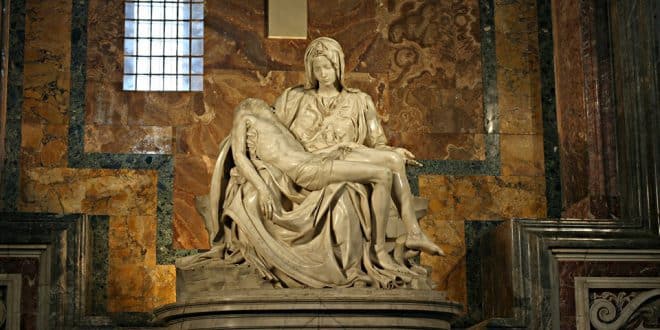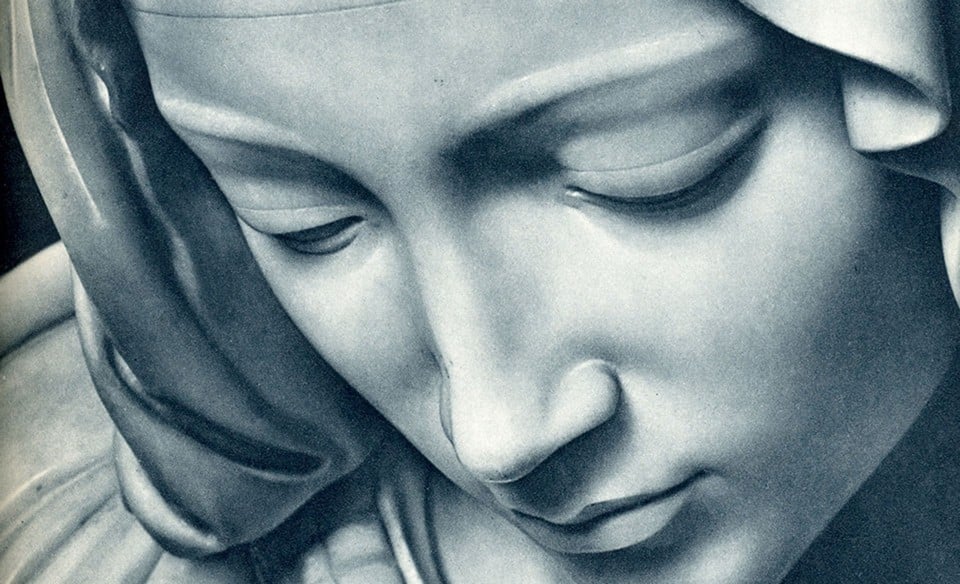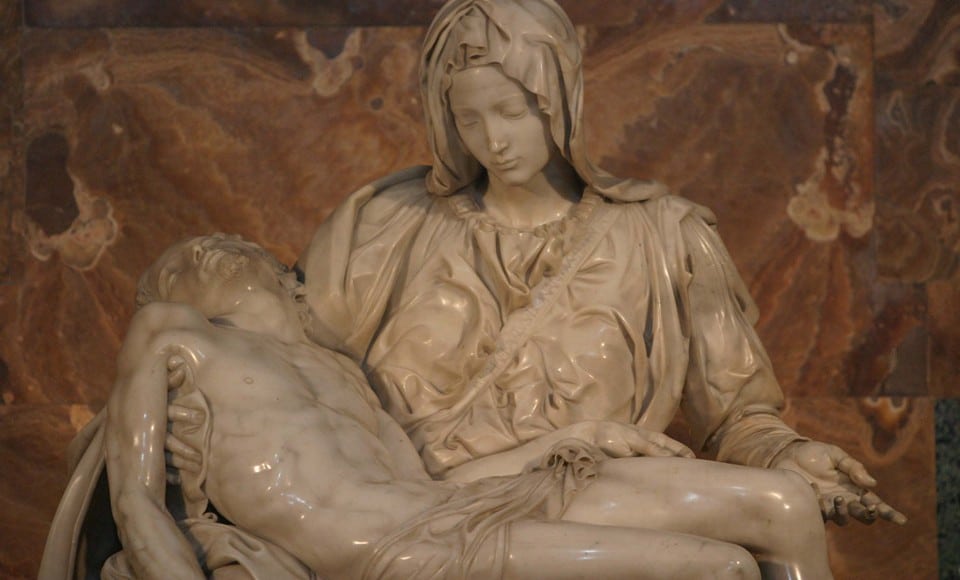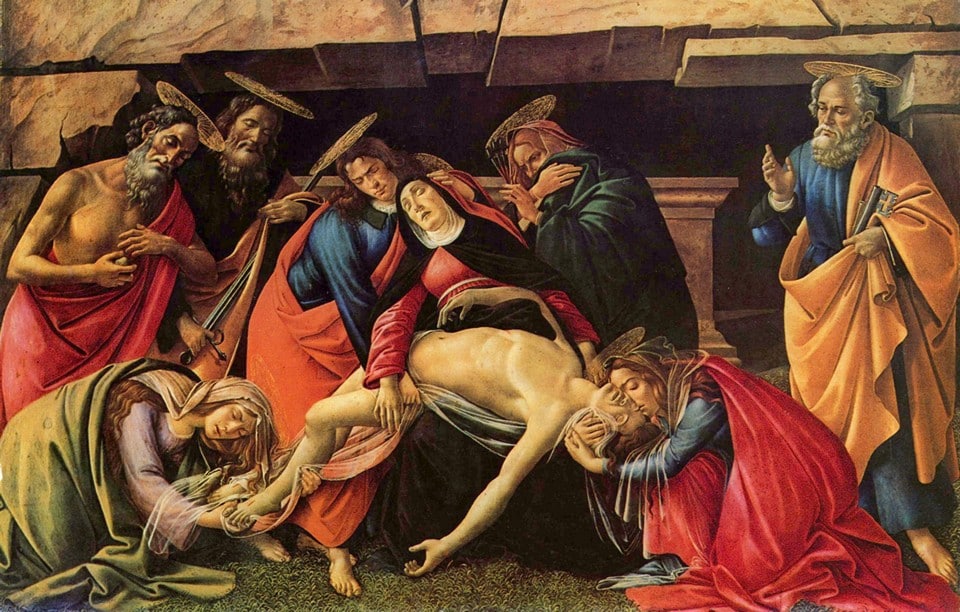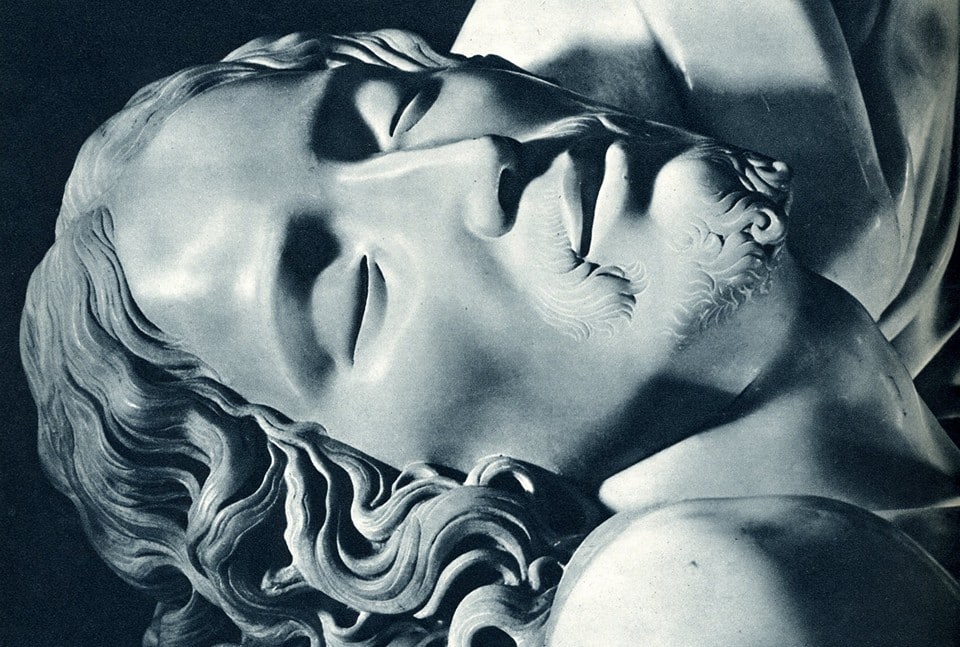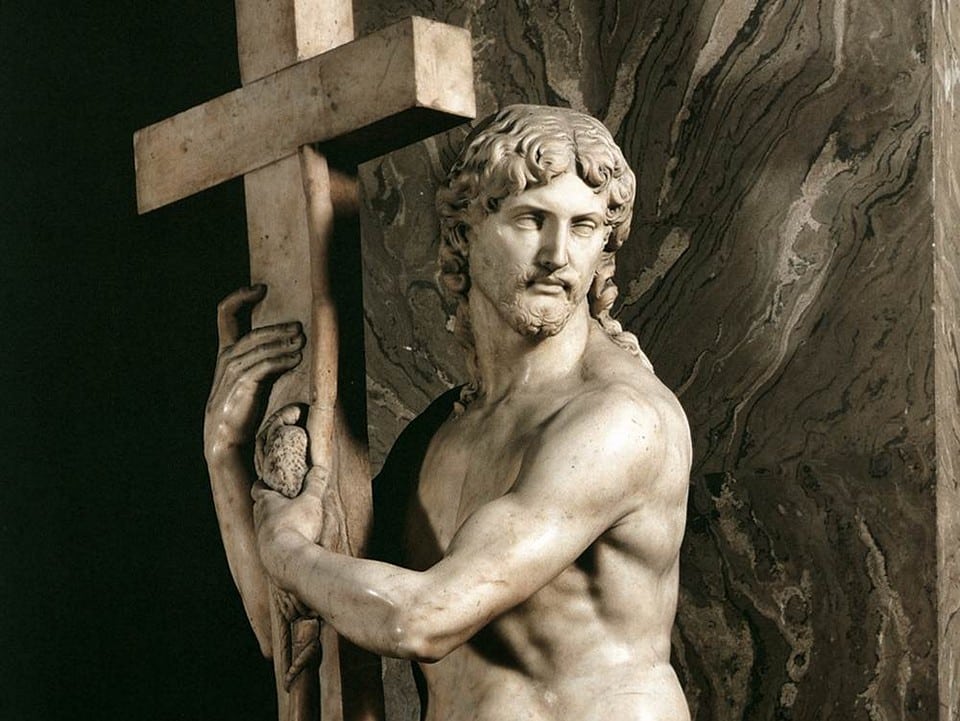Michelangelo’s Pieta represents a mournful image of Mary holding the crucified Christ taken down from the cross. One can see this masterpiece in St. Peter’s Basilica in the Vatican.
Italian Pietà means “compassion, sorrow, pity, sympathy.” The subject of this iconographic sculpture is not mentioned in the 4 Gospel texts, nor is it in the Apocrypha. But in Catholicism, the Pieta of Michelangelo Buonarroti is one of the most powerful images that has strong meaning for believers.
Page Contents
Overview
Michelangelo’s Pieta is a sculptural composition of pyramidal form, carved from a solid block of light marble. Michelangelo cut off all unnecessary things. As a result, a stunning image of a grieving mother who had lost her son appeared to the world. The sculpture is protected with glass and cannot be viewed from all sides. But anyway it conjures special feelings in those who believe in the atoning sacrifice of Jesus Christ.
I recommend to admire the Pieta without the queues and crowds of tourists during a private tour of the Vatican at dawn.
The veneration of the sorrows of the Virgin Mary originated in Christianity in the 14th century and was reflected in the European art of the time. The ribs and hands of the lifeless Jesus bear the marks of the wounds after Golgotha. It is striking how the young Michelangelo managed to express all the tragedy of what had happened.
The whole image of Michelangelo Buonarroti’s sculptural composition conveys the depth of the tragedy of the Holy Mother grieving over the body of Christ.
Her right hand holds the body in a pose familiar to women – the way infants are breastfed. But this is a mature man, and his head descends from his mother’s shoulder. The left hand seems to question – a mute question, expressed by the fingers of the grieving mother’s bewilderment at the aimless death of the sinless Christ. The cloak on His head is carelessly folded, the small folds of the cloth reveal to the maximum extent the forehead and the last gaze of the Holy Mother.
Mary stares in amazement not at the face of Jesus, but at the pierced ribs and hand, trying to capture the smallest details before giving His body up for burial. Art historians associate the fractures of the rough cloth with the fractures of the soul – of an irreparable loss. Her face does not express grief anymore, but the feeling that it is all behind, giving a last look at the Son and comprehension of what has happened. Perhaps the sculptor wanted to convey her recollection of the prophecy of Christ, who promised to rise on the 3rd day. Or perhaps this is what humility looks like – mute indifference from the fact that nothing can be changed.
The lifeless body of the 33-year-old Christ is on his mother’s lap. His face does not express the suffering that he has undergone, the head is thrown back, the entire figure is relaxed, but held by Mary. The hands and feet have nail marks from the crucifixion. The ribs of Jesus were pierced on the cross after his death, before he was taken down by Roman soldiers (so the Holy Scriptures tell us).
The figures of the characters of the biblical story are made full-length. Realism is also expressed in the obvious signs of the crucifixion and the mournful and humble countenance of Mary.
Christ’s mother is depicted as young lady, without deep wrinkles of age, although she was about 50 years old at the time of the crucifixion of the Firstborn. The theological canons have been violated, but art historians insist on the idea that this is how the purity of soul and spirituality of the Immaculate Virgin was portrayed during the Renaissance. According to prophecies, the Holy Mary is known to have conceived Christ by the Holy Spirit. After Jesus was born, she and Joseph had other children conceived naturally. But in Christianity, it is customary to speak of her as the Immaculate and Blessed Mary, the Virgin Mary and Mother of our Lord Jesus Christ. That is why all paintings and sculptures depict her as a young and pretty virgin.
The work was long and painstaking, few believed that an unknown 24-year-old artist and beginner in sculptor could cope with such a task. But the result surpassed all expectations – no one could overbid this masterpiece of Michelangelo, both in aesthetics and strength of emotional embodiment.
Michelangelo Buonarroti was asked the question: “How do you manage it – not to make a single mistake, given that it is a stone, not a clay?” The master replied: “Nothing complicated, I keep the perfect image in my mind and cut off everything superfluous from the block of marble!”
The destruction of the masterpiece and its restoration
One of the most famous statues has been damaged several times – during its transportation and by a mad vandal’s attack. In 1972 the statue was damaged with a hammer by an obsessed Hungarian, Laszlo Tóth (a geologist working in Australia). Laszlo fancied himself as one of the incarnations of Christ. He used a rock hammer to beat off about 50 pieces of marble before the guards grabbed him and handed him over to the police.
He managed to damage the face of the Virgin Mary, and part of the nose and veil were beaten off, as well as Christ’s hand. Some pieces were lost, but many were immediately returned to the ministers of the temple by tourists and eyewitnesses. After restoration, it has regained its original appearance, although the lost fragments were cut from the less important areas of the sculpture in the background.
Spectral analysis showed that part of Mary’s left arm (up to the elbow) had been chipped off a couple of centuries ago, but perfectly restored. During one of the recent transportations, 4 fingers of the left hand were chipped, but restoration work has corrected this as well.
Since then, the Pieta sculpture has been securely protected by tempered glass from madmen. Italian restorers have done their best to make Michelangelo Buonarroti’s Pieta in St. Peter’s Basilica (Vatican City) look like new. The composition is illuminated on a pedestal, so that even behind the acrylic glass it is perfectly visible to pilgrims and tourists in the main Vatican cathedral.
History of the creation of Michelangelo’s Pieta
Interest in the biblical story of the time between the crucifixion of Jesus and his miraculous resurrection has long troubled the minds of Christians of different denominations. Since the days of Gothic sculpture and Early Renaissance art, Italian masters as well as masters from other neighboring European countries have been creating the mournful image of Mary’s loss of the Son.
For sure, Perugino’s ‘Mourning of Christ’ (1493-1494, now in the Uffizi Gallery, Florence) and Botticelli’s ‘Pietà’ (1495) encouraged many artists to reflect this tragic scene in stone and on canvas.
No one believed in Michelangelo’s success, but not only did he do an excellent job, he surpassed his talented teachers. Pietà made him famous throughout Rome, and soon Florence and the whole Italy were talking about his work.
Not everyone in religious and bohemian circles accepted that an unknown young sculptor could make a significant contribution to art and overbid the masterpieces of Antiquity and Ancient Rome. Michelangelo partly broke the canons, taking into consideration successful findings of his predecessors, but abandoned others.
The Pietà was created for Cardinal Jean Bilard de Lagrol. The Cardinal served as French ambassador to the court of Pope Alexander VI Borgia during the time of Charles VIII. The marble composition was intended for the chapel of Saint Petronilla, which belonged to the French community. It is unlikely that the young sculptor could have received such an order, but he was vouched for by an influential patrician, the Roman banker Jacopo Galli, admirer of Michelangelo’s talent.
Michelangelo had to make his best to justify given trust and work off a generous honorarium of 450 gold ducats.
The contract was concluded on May 26, 1498, and the sculptor together with workers went to Carrara to pick up a block of marble to choose and deliver the material to the site. Galli went bail for Michelangelo that within a year the Pieta would be in the gaze of the skeptics and envious. The work took longer, but a bet was won and the mournful sculpture became Rome’s most beautiful marble creation.
The fact that the masterpiece was recognized is confirmed by multiple copies around the world. Some artisanal workshops make crude forgeries for wealthy customers. They can see their Pietas in their gardens by the fountain or among the sculpted copies of world masterpieces.
Michelangelo’s only signed work
‘The Mourning of Christ’ is one of the greatest Michelangelo’s favorite works. After completing it, the sculptor went to Florence. But witnesses testified that he visited his greatest creation in Rome at every opportunity. No one knew what exactly attracted him: the aesthetics of the statue or the image of that contrast of the living and dead body.
Michelangelo, as his contemporaries claimed, lived as an ascetic and was tacit. He never entered into controversy, never defended his authorship, which was often under question. It was probably difficult for outside observers to recognize the genius of the young sculptor. And talentless envious people could not accept the fact that he had carved an inimitable masterpiece from stone.
Michelangelo did not leave his signatures on his creations. Even though the Pieta was autographed, it was a wrong signature!
During a visit to his statue, Michelangelo pretended to be a visitor. He observed how real visitors reacted to his work of art. And once he heard a conversation of two of them, who denied Buonarroti’s authorship. One of them was arguing that only the Milanese sculptor Gobbo could have carved it in stone. The great master did not argue with his uninformed compatriots. Instead, he decided to perpetuate the authenticity of his masterpiece with an autograph on the dressing of Mary. Giorgio Vasari, poet and biographer of several Italian artists, mentioned this fact in his book.
The intention was so firm that Michelangelo decided to stay overnight in the basilica, and carved his name on the marble. However, the “poor artist” was semi-literate, so he made a mistake in the inscription of his name. To this day, no one has corrected it:
“MICHILANGELO BUONARROTI FLORENTINE EXECUTED”.
No one has dared to correct the wrong 5th letter. Although marble is a soft stone there was a risk to break the integrity of the autograph. The sculptor personally selected a piece of the purest rock, almost devoid of inclusions and cracks, by going to the Karar quarries. His efforts paid off – the magnificent nude-colored statue surpassed all expectations.
When the masterpiece was completed, the news quickly spread throughout Rome. Soon all of Italy was talking about Michelangelo Buonarroti’s Pieta, and many rushed to see it. The ingenious specimen was awarded the most honorable place in the Vatican, St. Peter’s Basilica. And young sculptors were obliged by their teachers to examine it as a model to follow.
One more autograph of the great master has reached our days. Although he personally destroyed majority of his sketches and works. At Sotheby’s auction 30 historical documents with autographs of celebrities were sold. Among them was the signature of Michelangelo of 1521 – it was the contract to pay for the work of two sculptors. They helped Buonarroti work on a statue of Christ in the Church of Santa Maria sopra Minerva in Rome. But that masterpiece remained unsigned.
You can see the statue of Christ during a private tour of Rome at dawn.
Read also about Statue of David by Michelangelo in Florence.
Interesting Facts about Pieta
- The pattern of Mary grieving over the body of Jesus Christ removed from the cross is not new. It was reflected in the paintings and sculptures of the masters of the Early Renaissance. The level of the tragedy of these works made Michelangelo Buonarroti to do things a little differently and share his own vision.
- It was a hard to combine two full-length figures into a general sculptural composition without disturbing the proportions. However, the Michelangelo did it perfectly. It is worth remembering that this is marble, and the multi-ton block had to keep the balance once completed.
- The naturalism is expressed in the height of the Pieta figures. Experts have calculated that the height of Christ (if he had risen) would have been about 175cm. The hight of Holy Mary would be a little more. But this is natural for the composition of the grieving Mother with the Son in her arms.
- The figures of the famous sculpture were carved in marble for a cardinal from France. Such a masterpiece could not be left unknown. It was declared the “national treasure” of the Italians and a “model to follow”. So it was moved to the Vatican in the 18th century.
- The dimensions of the multi-ton sculpture are 174×195×69cm. The base for the Pieta was made in 1626 by Francesco Borromini. It is the only work by Michelangelo that bears his signature (on the dressing of the Holy Mary). As even before completion there were disputes about authorship and its authenticity.
Where is it located, how to see the work of the great master
You can enjoy Michelangelo’s Pieta behind bulletproof glass in St. Peter’s Basilica, Vatican.
Access is free, right at the entrance on the right in the first chapel. But it is at some distance and is visible only from the front view.
The cathedral is open daily from 7:00 a.m. to 6:30 p.m. It is always crowded, so if you wish to see it better come by its opening. And then you can proceed and attend our author’s tour of the entire Vatican for 6 HOURS.
 Italy for me From Italy with love
Italy for me From Italy with love

